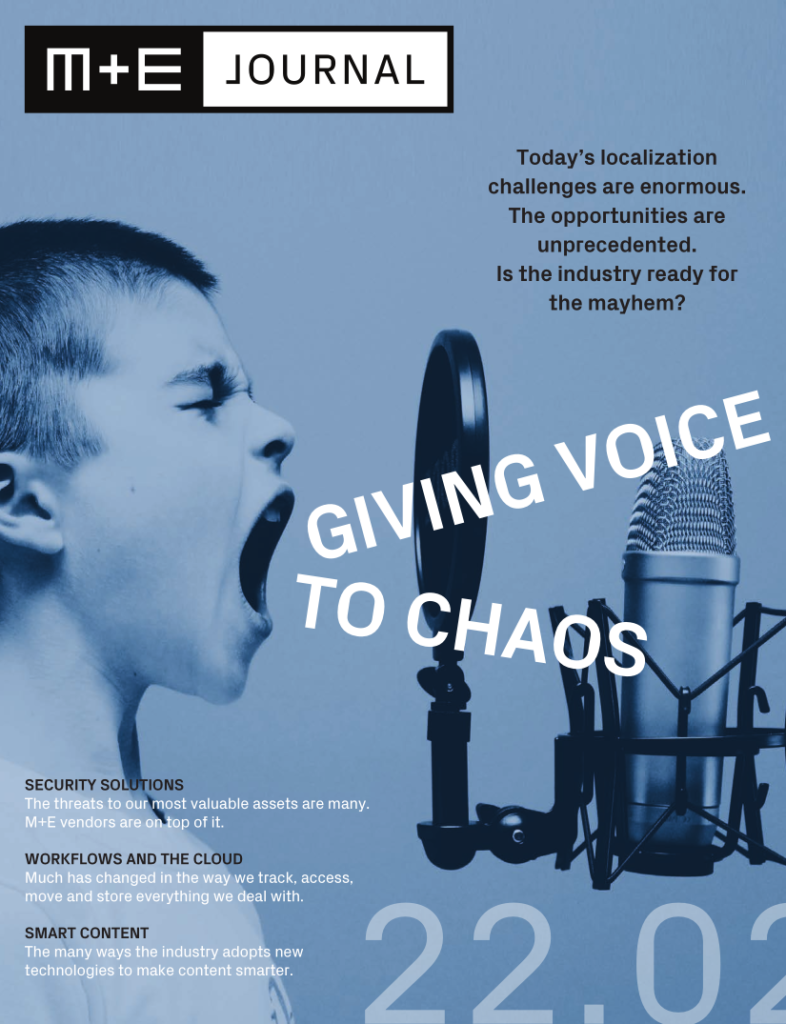
MESA’s Winter M+E Journal Goes Live
The winter edition of the “M&E Journal,” published by MESA and geared toward senior media and entertainment executives who oversee their companies’ digital futures, is now available online.
The 134-page publication features insights from more than two dozen MESA members, from AppTek to XL8, with the issue’s main focus centered on the challenges and opportunities facing the localization end of the media and entertainment business.
Along with the cover section — “Giving Voice to Chaos” — the issue offers industry insights for several crucial industry areas, including “Workflows and the Cloud,” “Smart Content,” and “Security Solutions.” Additionally, the “M&E Journal” also features columns from MESA’s executive leadership.
Here’s a quick look at what’s included in the “Smart Content” section:
• “How Context Plays a Supersized Role in Scene Analysis” by Spherex’s Teresa Phillips and Kira McStay. Today’s technologies that detect NSFW content in videos fall short in assessing film and TV for global distribution. General labels like gun, nudity, and alcohol lack specificity, context, and meaning. Spherex AI applies deep knowledge of cultural sensitivities and regulatory environments to move beyond content detection to content decisions.
 • “Metadata Fundamental to the Evolution of Content Distribution” by MetaBroadcast’s Peggy Dau. As bundles and ad-supported services once again become the new normal for video distribution, the value of metadata cannot be ignored. Content discovery and ad-insertion are impossible without aggregated and enriched metadata. Cloud-enabled metadata processing is the key to ensuring video service evolution.
• “Metadata Fundamental to the Evolution of Content Distribution” by MetaBroadcast’s Peggy Dau. As bundles and ad-supported services once again become the new normal for video distribution, the value of metadata cannot be ignored. Content discovery and ad-insertion are impossible without aggregated and enriched metadata. Cloud-enabled metadata processing is the key to ensuring video service evolution.
• “The Way to Multi-Lingual Content Localization” by Synaptica’s Ahren E. Lehnert. Content localization depends on language and imagery created specifically for regionalized markets. Localizing content text requires translation into one or more languages and possibly regional dialects. Managing concepts and textual blocks to serve to specific markets can be improved by using multi-lingual taxonomies to support localized concepts.
• “The Next Way We Do Entertainment Production” by Perception Grid’s Daniel Kenyon. Profound changes in the distribution model, coupled with significant advances in creative technologies, both accelerated by the COVID-19 pandemic, pushed the old paradigm to the brink and over the edge.
• “Introducing the Composable Customer Data Platform (CDP)” by Databricks’ Dan Morris. As we move toward a cookie-less world with customer expectations that entertainment will be available everywhere, companies that want to engage their customers effectively must build actionable intelligence on top of their first-party data. There are three challenges to achieving this, all difficult: build a rich, behavioral data set of customer interest and intent; then use that data to make meaningful inferences and predictions about individual customers at scale; and activate that intelligence across a myriad of customer touchpoints and marketing channels. As a result, many companies are turning to composable customer data platforms (CDPs) to bridge these gaps and overcome these significant challenges.
Beginning Monday, Jan. 9, look for stories from the spring edition of the “M+E Journal” every week in the “M+E Daily” newsletter.
